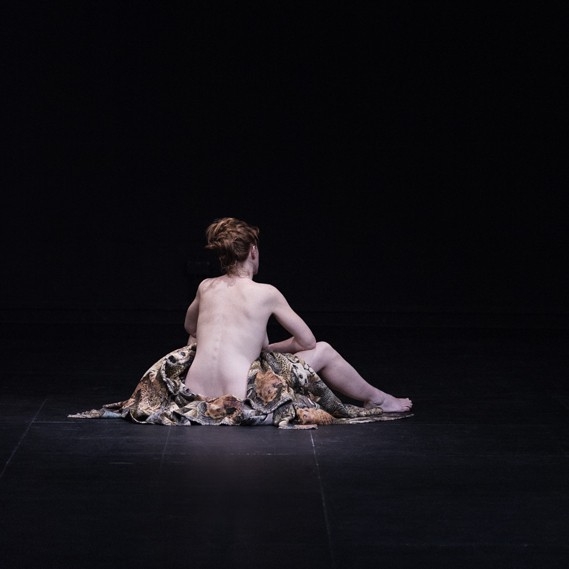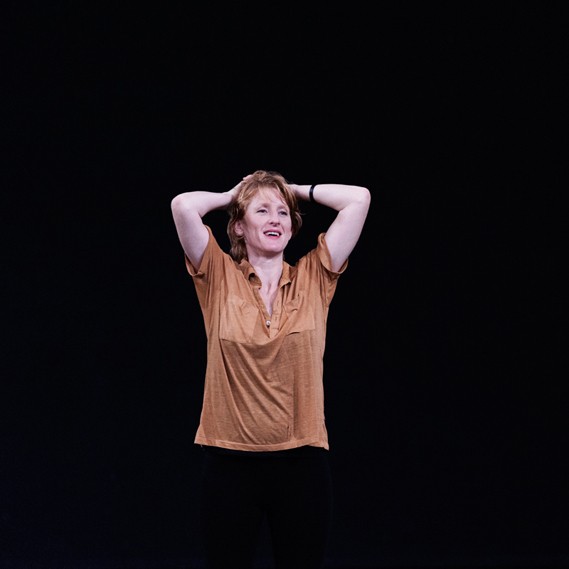Llámame Lola
When I first met Lola Rubio, the things that struck me about her were her Spanish accent, her hoarse voice, and her red hair. It was in 2002, in Montpellier. Her first name evokes a French film, and her last name the colour of her hair.
Since then, I have often seen her dance on stage. We have met several times. We have spent time together, just for fun, in different cities, eating cheesecake, and drinking late into the night.
She introduced me to Lucio, her 4-year-old son whom she is raising in Berlin on her own. He has her same milky white skin and could be a 1:4 scale model of his mother.
This project has been thought of as a choreographic portrait of Lola Rubio. Using her experience as a performer, we are expanding her relationship to the stage, most of which is usually hidden – the relationship to off-stage spaces, to the wings, to stage fright, and to preparation. The goal is to reveal her most hidden aspects as well as everything responsible for the singularity of her personal path.
Above all else, this path traces the portrait of a complex woman. It conjures up memories from her childhood, when she would watch her mother dance at weddings, the last time she took a bow on stage, the dance she had the most fun performing, and so on.
On stage, Lola Rubio shows us her back, inversing the front and the rear of the stage, like a projection space in order to reveal an underside. This also allows her to share what she is experiencing on stage.
“No me llames Dolores, Llamame Lola” (title of a Concha Piquer song)
- Mickaël Phelippeau
The premiere took place in October 2015 at L'échangeur - CDCN Hauts-de-France, in the frame of festival "C'est comme ça !"
a choreographic piece by Mickaël Phelippeau
artistic collaboration and performance Lola Rubio
light designSéverine Rième
production set-up Fabrik Cassiopée - Isabelle Morel
production, distribution, administration Fabrik Cassiopée – Manon Crochemore, Pauline Delaplace & Marie-Laure Menger
acknowledgments Lucio Rubio, Arantxa Martinez & Sonia Noya
executive producer bi-p association
coproduction Théâtre Brétigny, scène conventionnée / fabrik Potsdam (DE) in the frame of the program ÉTAPE DANSE, driven by l’Institut Francais Deutschland - Bureau du Théâtre et de la Danse and fabrik Potsdam, with the help of Ministère de la Culture-DGCA, SACD and the city of de Potsdam / Le Phare, Centre Chorégraphique National du Havre Haute-Normandie / Uzès Danse, CDC de l’Uzège, du Gard et du Languedoc Roussillon / L’échangeur, CDCN Hauts-de-France (FR) / Centre Chorégraphique National de Caen/Basse-Normandie (FR), in the frame of accueil studio.
Residencies Bureau du Théâtre et de la danse – Berlin (DE), Fabrikpotsdam – Potsdam (DE), in the frame of the program Etape Danse of Institut Français, Le Phare, Centre Chorégraphique National du Havre Haute-Normandie, in the frame of the program « Un artiste un collège », Centre chorégraphique national de Tours / Direction Thomas Lebrun Centre Chorégraphique National de Caen/Basse-Normandie (FR), in the frame of accueil studio.
photo credits Philippe Savoir & Mickaël Phelippeau
Creation 2015
2015
L'échangeur, CDCN Hauts-de-France - Festival C'est comme ça, Château-Thierry - premiere
Théâtre Brétigny, scène conventionnée, FR
2016
Fabrik Potsdam - Made in Postdam, DE
Maison de la Musique de Nanterre, FR
Théâtre Louis Aragon, scène conventionnée danse de Tremblay-en-France, FR
Uzès Danse, Uzès, FR
2017
LE ZEF, scène nationale de Marseille, FR


